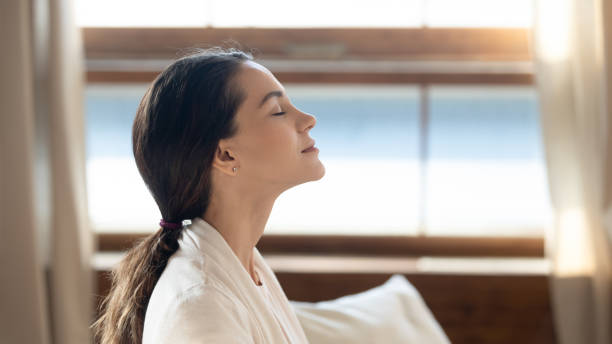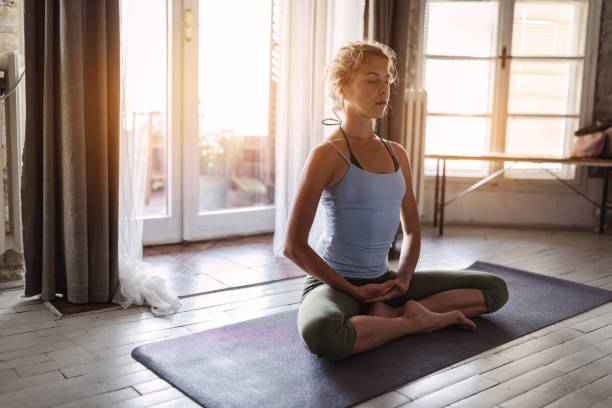15 Breathing Exercises to Reduce Stress
Stress refers to the psychological and physical reactions of the individual when faced with negative situations. Experiencing intense stress can reduce the quality of life and cause psychosomatic disorders. Therefore, reducing stress is important for mental health.
Breathing exercises are a method that can be used in cases of anxiety, stress and anger. In cases of stress or anxiety, our body can react differently than normal. Blood pressure and body temperature increase, breathing accelerates and we start taking short breaths. In these situations, the level of stress, anxiety and anger increases. When your breathing becomes laboured, you can hold your breath to take the first step towards calming down. Then, you can calm down by doing a breathing exercise.
You can do breathing exercises when your anxiety, stress and anger increase. You can also make these exercises a daily routine. For this, you should choose a quiet and calm environment. You can focus on your breathing more easily by closing your eyes during the exercises. Imagining yourself in a peaceful environment, breathe in peace and happiness as you breathe in, and breathe out stress and restlessness as you breathe out. You can continue the exercises until you feel good and do them several times a day. Remember, breath is the air we breathe involuntarily and the brain is nourished by breathing. With these exercises, you can control your breathing for a short time by focusing on the breath. If you are ready, let’s start.

1- Deep Breathing Technique
Deep breathing is a method used to deal with stress, anxiety and other emotional difficulties. This technique is used to slow the breath, relax the mind and reduce tension in the body. Deep breathing can be an alternative to fast and superficial breathing habits to calm and relax.
To breathe deeply, sit or lie down in a comfortable position. Inhale through your nose and exhale slowly, inflating your chest and abdomen. Repeat this inhalation and exhalation several times. You can calm your mind by closing your eyes during this technique.
This technique relaxes the body by reversing the tendency to breathe quickly and superficially in a stressful situation. Deep breathing lowers blood pressure and slows the heart rate, relaxing the body. It also increases the body’s oxygen intake, helping the mind to become more focused and clear.
Deep breathing techniques can vary according to the needs and abilities of different people. These techniques can be combined with other relaxation methods to give a more effective result. Deep breathing is a simple technique that can be used to reduce stress, calm the mind and improve overall health. Therefore, it can be used as a tool to cope with stressful situations by applying it in daily life.
2- Equal Duration Breathing Exercise
Equal-paced breathing is one of the most popular of the many different breathing techniques. This technique helps us to control our body’s physiological responses by using different breathing rhythms.
This exercise technique starts with inhaling and exhaling through the mouth or nose and continues with slow, rhythmic breathing. For example, you inhale for a period of four seconds and exhale for a period of four seconds. By repeating this process for several minutes, you can calm your mind by calming your body.
This technique can be used to alleviate various health problems such as stress, anxiety, depression, sleep disorders, blood pressure problems. This technique can be easily practised by many people and can be done at any time of daily life. It can also be used in combination with other relaxation techniques such as meditation and yoga.
In order to achieve relaxation with breathing exercises of equal duration, it is important to practice correct breathing techniques. By doing these exercises regularly, you can gain deeper breathing skills. These exercises are especially useful for those who want to learn to combat physiological reactions to stress.
3- Muscle Relaxing Breathing Exercise
Muscle relaxation breathing is an effective method for dealing with stress and anxiety. This exercise helps to reduce muscle tension and calms the body. It is especially recommended to combat physical symptoms such as stress-induced headaches, migraines, jaw pain, neck pain, lower back pain and other muscle aches.
To do this exercise, choose a calm and quiet environment and sit in a comfortable position. Take a deep breath in and then exhale slowly, opening your mouth slightly. As you exhale through your mouth, relax your muscles at the same time. During the exhalation, feel your muscles relax. After completing the exhalation, take a deep breath in again and repeat this process several times.
In addition to relaxing the body, the muscle relaxation breathing exercise also helps to calm the mind. If done regularly, this exercise can be an effective way to deal with stress. Muscle relaxation breathing can be done at any time and in any place. The only thing you need to do is to take a few minutes and control your breathing.
4- Lion Breathing Exercise
The Lion Breathing Exercise is a breathing technique commonly used in practices such as yoga and meditation. This exercise is designed to reduce the tension accumulated in the body and relieve stress.
The Lion Breathing Exercise begins by taking a deep breath. Then, we breathe out strongly through the mouth by opening our mouth and sticking out our tongue. During the exhalation, we open our throat and make a sound like “ahhh” or “rahh”. This sound is likened to the roar of a lion and gives the exercise its name.
When doing this exercise, you can close your eyes and focus on feeling your body and your breath. You can release the tension in your body by taking a deep breath in and making a sound as you breathe out quickly. During this exercise, you can also lift your shoulders up while contracting your abdomen.
The Lion Breathing Exercise is a great way to calm your mind and reduce stress. During the exercise, you can simplify your mind by focusing your attention on your breathing. You can also achieve relaxation by reducing the stress and tension accumulated in your body. The Lion Breathing Exercise is suitable for people of all ages and levels. You can do this exercise regularly to get rid of the stress of daily life and improve your mental health. However, if you have a serious respiratory or throat problem, it is recommended to consult your doctor before doing this exercise.

5- Puckered Lip Breathing Exercise
The puckered lip breathing exercise is an effective technique that helps to slow down, relax and calm down. This exercise can increase concentration, reduce stress and help you feel more relaxed in general.
This exercise requires you to initially sit in a comfortable position. Keep your back straight and relax your shoulders. Take a deep breath in through your nose and exhale slowly through your mouth, pursing your lips. Exhale as slowly and controlled as possible.
This exercise works by focussing on the puckering of the lips, especially when exhaling. The pursed lips make a harsh sound as you exhale. This sound can be used as a meditation technique to help you relax and unwind.
When practising the pursed lips breathing exercise, make a harsh “sssss” sound as you exhale for one minute and then inhale relaxed. You can repeat this exercise several times.
The pouty lip breathing exercise is a useful technique for anyone who has feelings of stress, anxiety and tension. This exercise provides a feeling of relaxation by slowing down the rhythm of breathing. When practised regularly, it can help you relax and calm your mind, leading to better focus.
6- Diaphragm Breath
Diaphragmatic breathing is one of the most basic of the correct breathing techniques. Normally, people breathe in and out using the rib muscles located in the rib cage area. However, this technique does not allow enough oxygen to be taken in and carbon dioxide to be expelled. Diaphragmatic breathing helps to use your respiratory muscles correctly and allows you to take in more oxygen.
Diaphragmatic breathing is a breathing technique that uses the diaphragm muscle. The diaphragm muscle is a layer of muscle that lies under the rib cage and separates the abdomen. This muscle contracts when inhaling and relaxes when exhaling. When doing diaphragmatic breathing, inhale slowly through your nose and inflate your abdomen using your diaphragm muscle. Breathe out slowly through your mouth and let your diaphragm muscle relax again.
Diaphragmatic breathing can also be used to deal with stress, anxiety and nervousness. This exercise relaxes the muscles in your body and allows you to enter a calmer state of mind. By doing diaphragmatic breathing exercises every day, you can improve the quality of your breathing and react more relaxed and calmly in stressful situations.
7- Chest Stretching Breathing Exercise
Chest-stretching breathing exercise is a technique that is often used during yoga and meditation. This exercise strengthens the muscles in the upper body and improves breathing capacity. It can also be used to combat stress and anxiety.
To do this exercise, lie on the floor on your back and bend your knees. Place your hands on your chest and lift your back off the floor, stretching your shoulders and upper back muscles. Inhale and expand your chest. Then hold the breath and squeeze your chest with your muscles and stay like this for a few seconds. Finally, exhale and return your chest to its original position.
When doing this exercise, instead of pulling your shoulders towards your ears, stretch your shoulders downwards. This way, you “ll relax the muscles in the shoulder and neck area and you “ll be able to breathe more efficiently.
Chest-stretching breathing exercises, when done regularly, can increase lung capacity and help clear the airways. It can also be used to deal with emotional difficulties such as stress and anxiety. By combining this exercise with other relaxation techniques such as yoga and meditation, you can improve your physical and mental health.
8- In-Take-Hold-Out Breathing Exercise
Al-Tut-Ver is one of the most basic and effective methods of breathing exercises. During this exercise, breath is inhaled through the nose, held for a few seconds after inhalation and then slowly exhaled through the mouth. The effect of this exercise is to calm the body and mind by controlling breathing. This exercise is a simple method that can be used in stressful situations in daily life.
This exercise can be used for many different purposes. For example, it can be used to overcome insomnia, lower high blood pressure, alleviate anxiety, increase concentration, and even calm irritability.
To do the Al-Tut-Ver exercise, sit in a comfortable position and inhale slowly through the nose. Once inhaled, hold the breath for a few seconds and then slowly exhale through your mouth. You can feel the difference by repeating this exercise several times a day.

9- Alternating Breathing Exercise (Nadi Shodhana Pranayama)
Alternate breathing is an important part of yoga and pranayama practices. This exercise, called “Nadi Shodhana Pranayama” in Sanskrit, calms the body and mind by balancing the flow of energy between the right and left nostrils.
In this exercise, first sit in a meditation position (such as Lotus or Half-Lotus) and relax the body. Then place your right hand over your nose and close the left nostril with your finger. Inhale slowly through the right nostril and then exhale through the left nostril, releasing the left nostril. Then, in the same way, close your left nostril, inhale through your right nostril and exhale through your left nostril, releasing your left nostril. Repeat this process alternately between the right and left nostrils.
This exercise calms the mind and reduces stress by increasing the body’s oxygen intake. It also improves concentration and thinking ability by balancing the activation of the left and right brain hemispheres. When practised regularly, alternate breathing exercise can also have positive effects on the nervous system, heart health, respiratory function and the immune system.
However, some people, such as those with respiratory problems, pregnant women or those with heart disease, should consult their doctor before doing this exercise. If you feel uncomfortable during the practice, stop the exercise and consult a specialist.
10- Resonant Breathing Exercise
Resonant Breathing is a breathing exercise based on the process of inhaling and exhaling rhythmically using the diaphragm correctly. This exercise can reduce stress levels in the body and calm the mind, creating a calming and relaxing effect.
To do the Resonant Breathing Exercise, you should first take a comfortable position. Place your feet and keep your back straight. Then, place one hand on your chest and the other on your abdomen. The goal here is to breathe using the diaphragm correctly. Take a deep breath and feel your diaphragm expanding. Hold your breath and then slowly exhale. Repeat this way several times.
Next, take a deep breath in through the nose and slowly exhale through your mouth. As you exhale, try to make a sound like “hah”. This sound is called “om”. After a while, start making the “om” sound in a unique rhythm. This will create a sound that creates vibration in your body. Continuing in the same rhythm, close your left nostril with your fingers and breathe in through your right nostril. Then open your left nostril and close your right nostril, exhale through your left nostril. Continue in this way several times.
The Resonant Breathing Exercise can have a calming and relaxing effect on the mind. This exercise can be done before going to bed or before a stressful situation. However, you shouldn “t force yourself to do it and you should start slowly. Also, try to be in a comfortable and quiet environment when doing the exercise.
11- Shitkari Breathing Exercise
Shitkari breathing exercise is one of the yoga pranayama techniques and is used to calm the body. This exercise is a technique of drawing in cold air through inhalation. “Shitkari” means “cold” in Sanskrit.
Shitkari breathing is useful for relaxation in hot weather and high humidity, especially in summer. It can also be applied when you are feeling stressed, anxious and irritable. Shitkari breathing calms not only the body but also the mind.
How is it done? First, take a comfortable sitting position. With the mouth open, gently press your teeth against your upper lips and form a tube by contracting the shape of the lips. Breathe in through the mouth and exhale through the mouth, passing the cold air between the lips. You can create a deeper sense of relaxation by combining the Shitkari breathing exercise with diaphragmatic breathing.
This exercise calms the nervous system, lowers blood pressure and calms the mind. It also reduces dry mouth, cools the body and increases energy levels. Shitkari breathing exercise can be done by people of all ages and can be incorporated into a daily routine.
However, those with respiratory problems such as asthma and those with oral health problems should consult their doctor before doing Shitkari breathing.
12- 4-7-8 Breathing Exercise
The 4-7-8 breathing exercise is a breathing technique developed by Dr Andrew Weil. This exercise is a meditation technique used to relieve stress, anxiety, and sleep problems. As the name suggests, the exercise focuses on breathing in and out in a certain rhythm.
In this exercise, sit in a comfortable position and close your mouth. When inhaling, take a deep breath slowly through your nose for 4 seconds. Then, hold the breath for 7 seconds. Finally, slowly exhale through your mouth for 8 seconds, during which you may hear a slight wheezing sound. This is a complete breathing cycle.
This exercise helps to slow down your heartbeat and relax your body by slowing the breath and increasing oxygen levels. Also, this exercise helps to learn to focus the breath and the mind. You can do the 4-7-8 breathing exercise at any time and in any place.
This exercise is especially useful in a stressful situation or on a sleepless night. Practising the exercise regularly can help manage stress and calm down. However, those with chronic respiratory problems or before performing breathing exercises regularly should consult their doctor.

13- 7-11 Breathing Exercise
7-11 Breathing Exercise is a breathing exercise used to cope with stress, calm down and combat sleep problems. When done regularly, this exercise relaxes the body, calms the mind and reduces stress levels.
During the exercise, inhale for 7 seconds while counting while inhaling, then count for 11 seconds while holding the breath, and finally exhale slowly for 8 seconds. This process is repeated in sequence. This exercise reduces the level of carbon dioxide in the body, allowing you to relax and provides oxygen to your mind.
7-11 Breathing Exercise is also recommended for people with sleep problems. Doing it before sleep provides relaxation and improves sleep quality. This exercise can also help treat health problems such as hypertension and anxiety due to its effects on lowering blood pressure, slowing the heart rate and the nervous system.
However, when doing the 7-11 Breathing Exercise, it is important not to strain during breathing in and out. It is important to breathe in and out in a slow and controlled manner and to feel relaxed during the exercise. Also, if any discomfort or shortness of breath is felt, the exercise should be paused.
